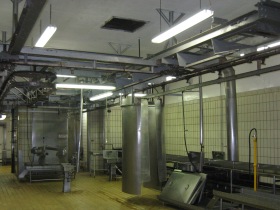Type of gas does not matter at pig slaughter

Pig welfare is not necessarily improved when, prior to slaughter, other kinds of anaesthetic gases than just CO2 are used. New Dutch research has showed these results.
The research©was carried out by the Animal Sciences Group (ASG), part of Wageningen University and Science Centre, under the authority of the Dutch ministry of agriculture, nature and food quality (LNV). The research was a result of questions in parliament.
Effects
ASG conducted some research into the effect of different gas mixtures onto the pigs’ anaesthetising. Apart from the conventional method (87% CO2 + in air), the following options were researched:
•©80% CO2 + 20% O2
•©70% CO2 + 30% O2
•©60% CO2 + 30% O2 + 10% N2
Per treatment, six animals were used and for all several different parameters were closely monitored, e.g. heart functioning and behaviour.
Adding oxygen did have some positive effects for the pigs’ heartbeat and sometimes the pigs were less short of breath. The researchers said that: “The only apparently positive sign in terms of animal welfare related to lowering of the CO2 concentration or increasing O2 to a CO2 concentration is a reduction of difficulty in breathing prior to loss of consciousness.”
Disadvantages
There were disadvantages as well, however. Sometimes pigs regained consciousness too quickly or they became unconscious too late, in cases when O2 was added to the gas mixture.
The researchers concluded that ‘there is possibly an effect on heart beats per minute due to adding O2 to the CO2 concentration’.
Two phases
Anaesthetising in two phases, such as that used when slaughtering poultry, did not prove to be the solution either. In poultry, first low concentrations CO2 are used to prevent stress. After a while, full anaesthetising follows. Pigs, however, will get grave breathing difficulties when inhaling low concentrations CO2 for a longer period.
In the opinion of ASG, slaughtering can be done more animal friendly, for instance by improvements in lairage, the moving and separating of the animals and the adjustment of anaesthetics.
Related websites
• Dutch ministry of agriculture, nature and food quality (LNV)
• Wageningen University & Research Centre
• Animal Sciences Group©
©











